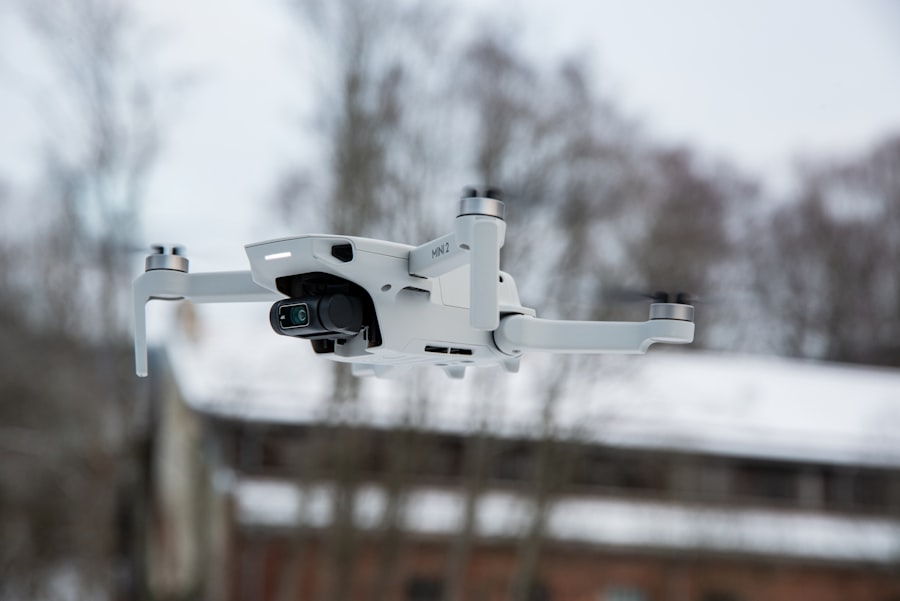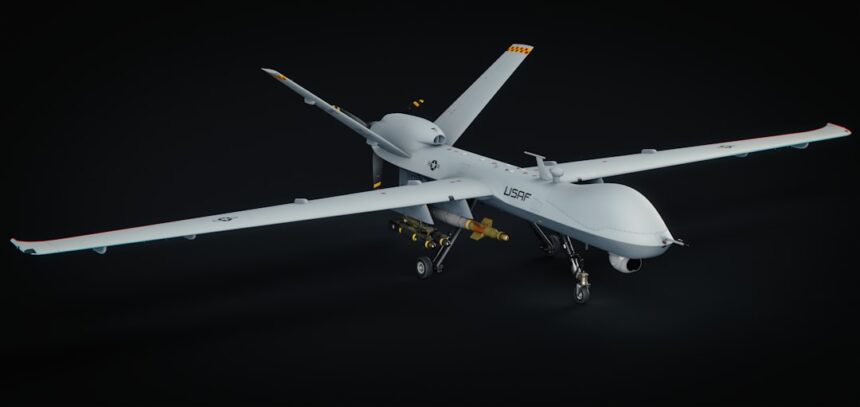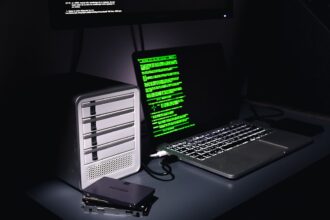In recent years, the emergence of drone technology has revolutionized various sectors, from agriculture to logistics. However, this innovation has also given rise to a new and alarming threat: drone swarm cyber attacks. A drone swarm consists of multiple drones operating in unison, often controlled by a single operator or an automated system.
This coordinated approach can overwhelm traditional defense mechanisms, making it a formidable challenge for cybersecurity experts. The potential for these swarms to be weaponized or used for malicious purposes raises significant concerns about national security, privacy, and public safety. The threat posed by drone swarms is not merely theoretical; there have been instances where drones have been used to disrupt critical infrastructure or conduct surveillance.
The sophistication of these attacks can vary, ranging from simple disruptions to complex operations that exploit vulnerabilities in cyber defense systems. As drone technology continues to advance, so too does the capability of malicious actors to deploy these swarms effectively. Understanding the dynamics of drone swarm attacks is crucial for developing effective countermeasures and ensuring the safety of both public and private sectors.
Key Takeaways
- Drone swarm cyber attacks pose a significant threat due to their ability to overwhelm traditional defense systems and cause widespread disruption.
- Current cyber defense systems are vulnerable to drone swarm attacks, as they are not equipped to handle the scale and complexity of such coordinated assaults.
- Countermeasures for drone swarm cyber attacks are being developed, including the use of AI and machine learning to detect and defend against these threats.
- Physical and digital barriers can be implemented to protect against drone swarms, but collaboration with government agencies and law enforcement is essential for effective defense.
- Regular risk assessments, vulnerability testing, and training of security personnel are crucial for preparing and responding to drone swarm cyber attacks.
Identifying Vulnerabilities in Current Cyber Defense Systems
Current cyber defense systems are often ill-equipped to handle the unique challenges posed by drone swarms. Traditional cybersecurity measures focus primarily on protecting networks and data from cyber threats, but they may overlook the physical aspects of drone technology. For instance, many organizations lack comprehensive strategies that address the potential for drones to infiltrate secure areas or disrupt operations through physical means.
This oversight creates a significant vulnerability that can be exploited by attackers. Moreover, existing defense systems may not be designed to detect or respond to the specific signatures associated with drone swarm activity.
As these swarms can adapt and change tactics in real-time, traditional detection methods may fail to recognize an impending attack. Identifying these vulnerabilities is the first step toward fortifying defenses against drone swarm cyber attacks.
Developing Countermeasures for Drone Swarm Cyber Attacks

To effectively counter the threat of drone swarm cyber attacks, organizations must develop a multi-faceted approach that encompasses both technological and strategic elements. One potential countermeasure involves the deployment of advanced radar systems capable of detecting multiple drones simultaneously. These systems can provide early warning signs of an impending swarm attack, allowing security personnel to take proactive measures.
Additionally, integrating these radar systems with existing cybersecurity frameworks can enhance overall situational awareness. Another critical aspect of developing countermeasures is establishing protocols for neutralizing drone swarms once they are detected. This could involve deploying jamming technology to disrupt communication between drones and their operators or utilizing directed energy weapons to disable drones in flight.
However, such measures must be carefully considered to avoid unintended consequences, such as collateral damage or interference with legitimate drone operations. A comprehensive strategy that balances offensive and defensive measures will be essential in mitigating the risks associated with drone swarm attacks.
Utilizing AI and Machine Learning to Detect and Defend Against Drone Swarms
| Metrics | Data |
|---|---|
| Number of drone swarms detected | 120 |
| Accuracy of AI detection | 95% |
| Number of successful defenses | 80 |
| False positive rate | 3% |
Artificial intelligence (AI) and machine learning (ML) technologies hold significant promise in enhancing the detection and defense against drone swarms. By leveraging vast amounts of data, AI algorithms can identify patterns and anomalies associated with drone activity, enabling faster and more accurate threat detection. For instance, machine learning models can analyze flight paths, communication signals, and other indicators to distinguish between benign and malicious drone behavior.
Furthermore, AI can facilitate real-time decision-making during a drone swarm attack. Automated systems can assess the threat level and recommend appropriate responses based on predefined criteria. This capability is particularly valuable in high-pressure situations where human response times may be insufficient.
By integrating AI and ML into existing cybersecurity frameworks, organizations can bolster their defenses against the evolving threat landscape posed by drone swarms.
Implementing Physical and Digital Barriers to Protect Against Drone Swarms
A comprehensive defense strategy against drone swarms must include both physical and digital barriers. Physical barriers may involve the installation of netting or other structures designed to intercept drones before they can reach critical infrastructure. These barriers can serve as a first line of defense, preventing unauthorized access while minimizing the risk of damage from falling drones.
On the digital front, organizations should implement robust cybersecurity measures that protect against potential hacking attempts aimed at controlling or disabling defense systems. This includes regular software updates, encryption protocols, and access controls to safeguard sensitive information related to drone operations. By creating a layered defense that combines physical and digital barriers, organizations can significantly reduce their vulnerability to drone swarm attacks.
Collaborating with Government Agencies and Law Enforcement to Combat Drone Swarm Threats

Addressing the threat of drone swarm cyber attacks requires collaboration between private organizations and government agencies. Law enforcement plays a crucial role in monitoring and regulating drone activity, ensuring compliance with existing laws and regulations. By working together, organizations can share intelligence about potential threats and develop coordinated responses to incidents involving drone swarms.
Additionally, government agencies can provide resources and expertise to help organizations enhance their defenses against drone threats. This collaboration may involve joint training exercises, information sharing platforms, and access to advanced detection technologies. By fostering a cooperative environment between public and private sectors, stakeholders can create a more resilient defense against the evolving challenges posed by drone swarms.
Training Security Personnel to Respond Effectively to Drone Swarm Cyber Attacks
The effectiveness of any defense strategy hinges on the preparedness of security personnel to respond to threats as they arise. Training programs focused on drone swarm cyber attacks should encompass both theoretical knowledge and practical skills. Security personnel must understand the unique characteristics of drone swarms, including their operational tactics and potential vulnerabilities.
Moreover, hands-on training exercises can simulate real-world scenarios involving drone swarm attacks, allowing personnel to practice their response strategies in a controlled environment. This training should also emphasize the importance of communication and coordination among team members during an incident. By equipping security personnel with the necessary skills and knowledge, organizations can enhance their overall readiness to combat drone swarm threats.
Conducting Regular Risk Assessments and Vulnerability Testing for Drone Swarm Defense
To maintain an effective defense against drone swarm cyber attacks, organizations must conduct regular risk assessments and vulnerability testing. These assessments should evaluate existing security measures and identify potential weaknesses that could be exploited by attackers. By proactively identifying vulnerabilities, organizations can implement targeted improvements to their defenses.
Vulnerability testing should also include simulations of drone swarm attacks to assess how well current systems can withstand such incidents. These tests can reveal gaps in detection capabilities or response protocols that need to be addressed. Regular assessments not only help organizations stay ahead of emerging threats but also foster a culture of continuous improvement in cybersecurity practices.
Integrating Drone Detection and Defense Systems with Existing Cybersecurity Infrastructure
For organizations to effectively combat drone swarm cyber attacks, it is essential to integrate detection and defense systems with existing cybersecurity infrastructure. This integration allows for seamless communication between various security components, enhancing overall situational awareness and response capabilities. By consolidating data from different sources, organizations can gain a comprehensive view of their security posture.
Moreover, integrated systems can facilitate automated responses to detected threats, reducing response times significantly. For instance, if a drone swarm is detected approaching a critical facility, automated protocols could initiate countermeasures without requiring human intervention. This level of integration not only improves efficiency but also enhances the overall effectiveness of an organization’s defense strategy against drone swarms.
Establishing Protocols for Incident Response and Recovery in the Event of a Drone Swarm Attack
In the event of a successful drone swarm attack, having well-defined incident response protocols is crucial for minimizing damage and facilitating recovery efforts. Organizations should establish clear procedures outlining roles and responsibilities during an incident, ensuring that all personnel understand their tasks in responding to a threat. Additionally, recovery protocols should focus on restoring normal operations as quickly as possible while conducting thorough investigations into the attack’s origins and impact.
This may involve collaborating with law enforcement agencies or cybersecurity experts to analyze data collected during the incident. By having robust incident response and recovery protocols in place, organizations can mitigate the long-term effects of a drone swarm attack.
Educating the Public and Private Sectors on the Importance of Defending Against Drone Swarm Cyber Attacks
Finally, raising awareness about the threat of drone swarm cyber attacks is essential for fostering a culture of vigilance within both public and private sectors. Educational initiatives should focus on informing stakeholders about the potential risks associated with drone technology and the importance of implementing effective defense strategies. Workshops, seminars, and online resources can provide valuable information on best practices for mitigating risks related to drone swarms.
By engaging with various stakeholders—ranging from corporate leaders to local government officials—organizations can promote a collective understanding of the need for robust defenses against this emerging threat. Ultimately, education plays a pivotal role in building resilience against drone swarm cyber attacks across all sectors of society.
In the rapidly evolving landscape of modern warfare, defending against drone swarm cyber attacks has become a critical focus for military strategists and cybersecurity experts alike. These swarms, capable of overwhelming traditional defense systems, pose a significant threat due to their ability to coordinate and execute complex maneuvers autonomously. An insightful article discussing strategies and technologies to counter these threats can be found on In The War Room’s website. For a deeper understanding of the current measures being developed to protect against such sophisticated attacks, you can read more in this




